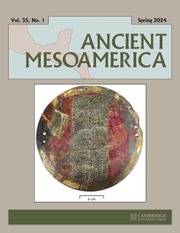Article contents
An account of the kings of Kanu'l as recorded on the hieroglyphic stair of K'an II of Caracol
Published online by Cambridge University Press: 04 October 2024
Abstract
Many questions remain about the hieroglyphic stair dedicated in a.d. 642 by K'an II, the great king of Caracol. Constituent panels have been found at Caracol, Ucanal, Naranjo, and Xunantunich—archaeological sites spread between Guatemala and Belize. The most recently discovered Panels 3 and 4 at Xunantunich shed light on the tumultuous decades of the seventh century. Panel 4, which opened the hieroglyphic stair, makes a surprising statement from the outset, clarifying that Kanu'l political authority was irrevocably established at Calakmul. This bold statement serves as a synoptic précis for the entire narrative and explains why the deeds of K'an II are related, but only to the extent that these could be interwoven with the history of the Kanu'l. This makes the hieroglyphic stair such an important source, because it tracks the rulers of the Kanu'l dynasty from the vantage of a close ally. These monuments attest to the fissioning of the Kanu'l dynasty and its eventual restoration at Calakmul, from whence Classic Maya politics would be overseen for the remainder of the seventh century. In this article, we build on earlier studies and add our most recent observations and new readings based on renewed inspections of the existing panels.
Resumen
Muchas preguntas quedan sobre la escalinata jeroglífica dedicada en 642 d.C. por K'an II, el gran rey de Caracol. Paneles constituyentes fueron descubiertos distribuidos entre una serie de diferentes sitios arqueológicos, incluyendo a Caracol, Ucanal, Naranjo y Xunantunich, lugares distribuidos entre Guatemala y Belice. Los paneles descubiertos más recientemente en Xunantunich contribuyen en gran medida a nuestra comprensión de este fascinante monumento y las tumultuosas décadas de la dinastía Kanu'l. Gracias a los descubrimientos realizados en Xunantunich, se han cerrado muchas lagunas, con los Paneles 3 y 4 que se destacan como el principio y fin de esta gran narrativa. El Panel 4 de Xunantunich—que abrió la narrativa que adornó la escalinata jeroglífica—hace una declaración sorprendente desde el inicio, aclarando que la autoridad política se había establecido resueltamente en Calakmul. Esta es una declaración audaz y sirve como resumen sinóptico para todo el texto de la escalinata jeroglífica, preparando el escenario y, por lo tanto, explicando la atención prestada a los reyes Kanu'l en la narrativa. Como tal, los hechos de K'an II son relatados, pero solo en la medida en que estos puedan entretejerse con las acciones de los señores de Kanu'l. Esta es la razón por la cual la escalera jeroglífica es una fuente tan importante para los asuntos dinásticos de los reyes Kanu'l, ya que rastrea a los gobernantes de la dinastía desde la posición ventajosa de un aliado. Estos monumentos atestiguan de la fisión de la dinastía Kanu'l y su eventual restablecimiento en Calakmul, desde donde se controlaría gran parte de la política maya clásica durante el resto del siglo VII. En esta contribución nos basamos en estudios anteriores y agregamos observaciones recientes y nuestras nuevas lecturas, realizadas a través de la inspección renovada de los paneles existentes.
Information
- Type
- Research Article
- Information
- Copyright
- Copyright © The Author(s), 2024. Published by Cambridge University Press
References
- 4
- Cited by


